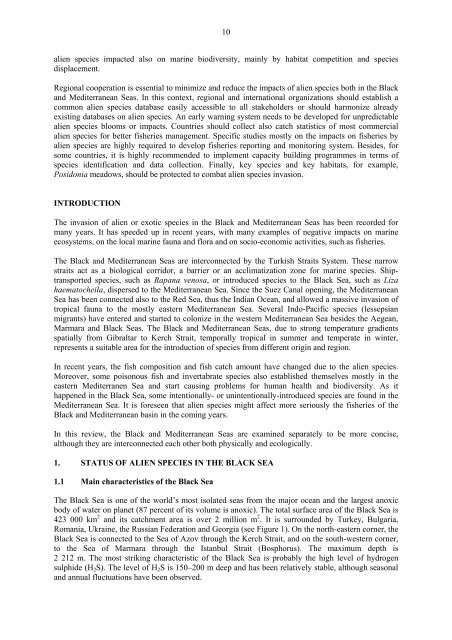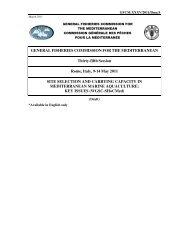Status of alien species in the Mediterranean and Black Sea
Status of alien species in the Mediterranean and Black Sea
Status of alien species in the Mediterranean and Black Sea
Create successful ePaper yourself
Turn your PDF publications into a flip-book with our unique Google optimized e-Paper software.
10<br />
<strong>alien</strong> <strong>species</strong> impacted also on mar<strong>in</strong>e biodiversity, ma<strong>in</strong>ly by habitat competition <strong>and</strong> <strong>species</strong><br />
displacement.<br />
Regional cooperation is essential to m<strong>in</strong>imize <strong>and</strong> reduce <strong>the</strong> impacts <strong>of</strong> <strong>alien</strong> <strong>species</strong> both <strong>in</strong> <strong>the</strong> <strong>Black</strong><br />
<strong>and</strong> <strong>Mediterranean</strong> <strong>Sea</strong>s. In this context, regional <strong>and</strong> <strong>in</strong>ternational organizations should establish a<br />
common <strong>alien</strong> <strong>species</strong> database easily accessible to all stakeholders or should harmonize already<br />
exist<strong>in</strong>g databases on <strong>alien</strong> <strong>species</strong>. An early warn<strong>in</strong>g system needs to be developed for unpredictable<br />
<strong>alien</strong> <strong>species</strong> blooms or impacts. Countries should collect also catch statistics <strong>of</strong> most commercial<br />
<strong>alien</strong> <strong>species</strong> for better fisheries management. Specific studies mostly on <strong>the</strong> impacts on fisheries by<br />
<strong>alien</strong> <strong>species</strong> are highly required to develop fisheries report<strong>in</strong>g <strong>and</strong> monitor<strong>in</strong>g system. Besides, for<br />
some countries, it is highly recommended to implement capacity build<strong>in</strong>g programmes <strong>in</strong> terms <strong>of</strong><br />
<strong>species</strong> identification <strong>and</strong> data collection. F<strong>in</strong>ally, key <strong>species</strong> <strong>and</strong> key habitats, for example,<br />
Posidonia meadows, should be protected to combat <strong>alien</strong> <strong>species</strong> <strong>in</strong>vasion.<br />
INTRODUCTION<br />
The <strong>in</strong>vasion <strong>of</strong> <strong>alien</strong> or exotic <strong>species</strong> <strong>in</strong> <strong>the</strong> <strong>Black</strong> <strong>and</strong> <strong>Mediterranean</strong> <strong>Sea</strong>s has been recorded for<br />
many years. It has speeded up <strong>in</strong> recent years, with many examples <strong>of</strong> negative impacts on mar<strong>in</strong>e<br />
ecosystems, on <strong>the</strong> local mar<strong>in</strong>e fauna <strong>and</strong> flora <strong>and</strong> on socio-economic activities, such as fisheries.<br />
The <strong>Black</strong> <strong>and</strong> <strong>Mediterranean</strong> <strong>Sea</strong>s are <strong>in</strong>terconnected by <strong>the</strong> Turkish Straits System. These narrow<br />
straits act as a biological corridor, a barrier or an acclimatization zone for mar<strong>in</strong>e <strong>species</strong>. Shiptransported<br />
<strong>species</strong>, such as Rapana venosa, or <strong>in</strong>troduced <strong>species</strong> to <strong>the</strong> <strong>Black</strong> <strong>Sea</strong>, such as Liza<br />
haematocheila, dispersed to <strong>the</strong> <strong>Mediterranean</strong> <strong>Sea</strong>. S<strong>in</strong>ce <strong>the</strong> Suez Canal open<strong>in</strong>g, <strong>the</strong> <strong>Mediterranean</strong><br />
<strong>Sea</strong> has been connected also to <strong>the</strong> Red <strong>Sea</strong>, thus <strong>the</strong> Indian Ocean, <strong>and</strong> allowed a massive <strong>in</strong>vasion <strong>of</strong><br />
tropical fauna to <strong>the</strong> mostly eastern <strong>Mediterranean</strong> <strong>Sea</strong>. Several Indo-Pacific <strong>species</strong> (lessepsian<br />
migrants) have entered <strong>and</strong> started to colonize <strong>in</strong> <strong>the</strong> western <strong>Mediterranean</strong> <strong>Sea</strong> besides <strong>the</strong> Aegean,<br />
Marmara <strong>and</strong> <strong>Black</strong> <strong>Sea</strong>s. The <strong>Black</strong> <strong>and</strong> <strong>Mediterranean</strong> <strong>Sea</strong>s, due to strong temperature gradients<br />
spatially from Gibraltar to Kerch Strait, temporally tropical <strong>in</strong> summer <strong>and</strong> temperate <strong>in</strong> w<strong>in</strong>ter,<br />
represents a suitable area for <strong>the</strong> <strong>in</strong>troduction <strong>of</strong> <strong>species</strong> from different orig<strong>in</strong> <strong>and</strong> region.<br />
In recent years, <strong>the</strong> fish composition <strong>and</strong> fish catch amount have changed due to <strong>the</strong> <strong>alien</strong> <strong>species</strong>.<br />
Moreover, some poisonous fish <strong>and</strong> <strong>in</strong>vertabrate <strong>species</strong> also established <strong>the</strong>mselves mostly <strong>in</strong> <strong>the</strong><br />
eastern Mediterranen <strong>Sea</strong> <strong>and</strong> start caus<strong>in</strong>g problems for human health <strong>and</strong> biodiversity. As it<br />
happened <strong>in</strong> <strong>the</strong> <strong>Black</strong> <strong>Sea</strong>, some <strong>in</strong>tentionally- or un<strong>in</strong>tentionally-<strong>in</strong>troduced <strong>species</strong> are found <strong>in</strong> <strong>the</strong><br />
<strong>Mediterranean</strong> <strong>Sea</strong>. It is foreseen that <strong>alien</strong> <strong>species</strong> might affect more seriously <strong>the</strong> fisheries <strong>of</strong> <strong>the</strong><br />
<strong>Black</strong> <strong>and</strong> <strong>Mediterranean</strong> bas<strong>in</strong> <strong>in</strong> <strong>the</strong> com<strong>in</strong>g years.<br />
In this review, <strong>the</strong> <strong>Black</strong> <strong>and</strong> <strong>Mediterranean</strong> <strong>Sea</strong>s are exam<strong>in</strong>ed separately to be more concise,<br />
although <strong>the</strong>y are <strong>in</strong>terconnected each o<strong>the</strong>r both physically <strong>and</strong> ecologically.<br />
1. STATUS OF ALIEN SPECIES IN THE BLACK SEA<br />
1.1 Ma<strong>in</strong> characteristics <strong>of</strong> <strong>the</strong> <strong>Black</strong> <strong>Sea</strong><br />
The <strong>Black</strong> <strong>Sea</strong> is one <strong>of</strong> <strong>the</strong> world’s most isolated seas from <strong>the</strong> major ocean <strong>and</strong> <strong>the</strong> largest anoxic<br />
body <strong>of</strong> water on planet (87 percent <strong>of</strong> its volume is anoxic). The total surface area <strong>of</strong> <strong>the</strong> <strong>Black</strong> <strong>Sea</strong> is<br />
423 000 km 2 <strong>and</strong> its catchment area is over 2 million m 2 . It is surrounded by Turkey, Bulgaria,<br />
Romania, Ukra<strong>in</strong>e, <strong>the</strong> Russian Federation <strong>and</strong> Georgia (see Figure 1). On <strong>the</strong> north-eastern corner, <strong>the</strong><br />
<strong>Black</strong> <strong>Sea</strong> is connected to <strong>the</strong> <strong>Sea</strong> <strong>of</strong> Azov through <strong>the</strong> Kerch Strait, <strong>and</strong> on <strong>the</strong> south-western corner,<br />
to <strong>the</strong> <strong>Sea</strong> <strong>of</strong> Marmara through <strong>the</strong> Istanbul Strait (Bosphorus). The maximum depth is<br />
2 212 m. The most strik<strong>in</strong>g characteristic <strong>of</strong> <strong>the</strong> <strong>Black</strong> <strong>Sea</strong> is probably <strong>the</strong> high level <strong>of</strong> hydrogen<br />
sulphide (H2S). The level <strong>of</strong> H2S is 150–200 m deep <strong>and</strong> has been relatively stable, although seasonal<br />
<strong>and</strong> annual fluctuations have been observed.
















